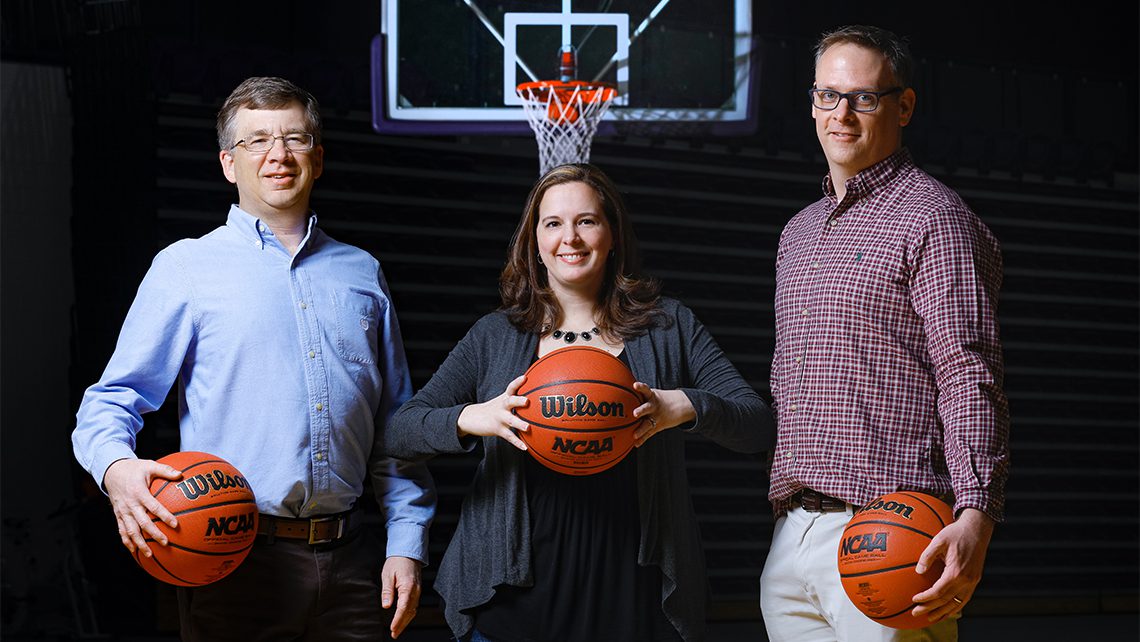Mathematics and March Madness

Research by professors included in New York Times story on Virginia loss
Furman mathematics professor John Harris ’91 isn’t telling you to pick Pennsylvania to beat Kansas in the NCAA tournament. A 16-seed has never defeated a top seed, after all, so that would be crazy.
He’s just saying … think about it.
“If someone did want to pick a 16 over a 1, this might be one to consider,” Harris says.
Harris doesn’t have insider knowledge about either team, and he’d be the first one to tell you he’s not a college basketball expert. You probably should still think about it.
That’s because Harris and math department colleagues Kevin Hutson and Liz Bouzarth have done more pondering about how to predict March Madness upsets than anybody you know. For five years now, the three have collaborated with ESPN senior writer Peter Keating, whose “Numbers” column covers the world of statistics and analytics in sports, to create some of the world’s most advanced metrics for predicting tourney upsets.
The story the numbers tell this year is one of potential peril for the Jayhawks on Thursday afternoon when the action gets under way. Emphasis on potential.
“We noticed something interesting about the Kansas-Penn game,” Harris says. “Our model says there is only a four-percent chance of an upset, so it’s very unlikely, but we did notice that the matchup itself is very similar to the Duke-Lehigh matchup from 2012.”
That year, Lehigh stunned Duke, 75-70, to become one of only eight No. 15 seeds to ever beat a No. 2 seed. Four percent isn’t much of a probability, but it’s a probability. And the nature of probability says a 16 will beat a 1 eventually.
If you’re looking for more realistic upset options to impress your office mates, the professors recommend focusing on a couple of matchups between 11 and 6 seeds. According to their calculations, San Diego State has a 34-percent chance of defeating sixth-seeded Houston, while they give Loyola a one-in-three shot at taking down Miami.
Further into the bracket, should Florida State and Xavier both advance to the second round, the analysis gives the Seminoles, seeded ninth, a healthy 42-percent chance to knock off the No. 1 seed Musketeers. Either winner of the Arkansas-Butler first-round game has a decent chance of knocking off second-seeded Purdue, with the No. 7 Razorbacks actually being favored.
ESPN Insider’s “Giant Killers” project predicts NCAA tournament upsets as defined by one team being seeded at least five spots higher than another, and prior to the 2014 tourney, Hutson, Bouzarth and Harris revolutionized its approach when they developed something that came to be called “cluster analysis.” In their cluster analysis, “giants” – the higher seeds – are lumped into four broad families based on their style of play, as are the “killers.”
Past results show trends in certain matchups between families, and as the data builds on itself the ability to predict future outcomes based on past performances theoretically becomes more accurate.
“The Arkansas-Purdue matchup in particular is interesting, because in that killer/giant cluster matchup the killer wins 55 percent of the time,” Hutson says.
Though their work won’t be used in Giant Killers in 2018, the three are still working with the network and ran data for this edition of the tournament.
“One of the things we often tell people to emphasize is we’re not necessarily picking the upset; we’re giving a probability we think the upset will happen,” Hutson says. “Traditionally upsets occur at about a 22-percent rate, so anything that is significantly above that we have as being more probable of an upset.”
The professors have more than a little history of success to lend credence to their methods. Last year, they gave No. 11 Xavier a 51-percent chance to upset No. 6 Maryland, which the Musketeers did easily. In 2016, their top four most likely first-round upsets all ended up being just that.
Though their computers look at every possible giant killer matchup through the tournament (“We make no assumptions. Sixteen seeds are allowed to have hypothetical games against eight and nine seeds,” Hutson says), the pickings were a bit slimmer this year for whatever reason and few potential upsets stand out compared to years past.
That’s OK. The trio, all college hoops fans, are ready to sit back and enjoy the games instead of analyzing them. Probability indicates, however, that Bouzarth, a North Carolina fan, won’t be enjoying it quite as much this time around.
“When I send out the bracket (pool) e-mail to the department, I always say may the best bracket and the best team win. But last year, my bracket won and my team won,” she says. “And I’m a Philadelphia Eagles fan. I am just riding all sorts of sports highs, but I’m kind of nervous it’s all going to come down at some point.”